Using Outer Joins
A Brief Overview
An outer
join returns nonmatching rows as well as matching rows.
|
Type of Outer Join
|
Output
|
|---|---|
|
Left
|
Returns all rows from
the left table (first table) and matching rows from the right table
(second table) that are specified in the FROM clause.
 |
|
Right
|
Returns all rows from
the right table (second table) and matching rows from the left table
(first table).
 |
|
Full
|
Returns all matching
and nonmatching rows from all the tables.
 |
Outer Join Syntax
|
Syntax, SELECT statement
for outer join:
SELECT column-1<,...column-n>
FROM table-1
| view-1 LEFT JOIN | RIGHT JOIN
| FULL JOIN table-2 | view-2
ON table1.column = table2.column
<other
clauses>;
LEFT JOIN, RIGHT JOIN, FULL JOIN
are keywords that specify
the type of outer join.
table
specifies the name
of the source table.
ON
specifies join conditions,
which are expressions that specify the column or columns on which
the tables are to be joined.
table.column
refers to the source
table and the column name on which the join occurs.
<other clauses>
refers to optional
PROC SQL clauses.
|
Note: To further subset the rows
in the query output, you can follow the ON clause with a WHERE clause.
The WHERE clause subsets the individual detail rows before the outer
join is performed. The ON clause then specifies how the remaining
rows are to be selected for output.
Note: You can perform an outer
join on only two tables or views at a time.
Example: Using a Left Outer Join
A left
outer join retrieves all rows that match across tables, based on the
join conditions, plus nonmatching rows from the left table (the first
table specified in the FROM clause).
Suppose you are using
a PROC SQL left join to combine the two tables One and Two. The join
condition is stated in the expression following the ON keyword.
proc sql;
select *
from certadv.one left join
certadv.two
on one.x=two.x
;
quit;
The two tables and the
three rows of output are shown below:
Output 3.10 PROC SQL Query Result: Left Outer Join Output
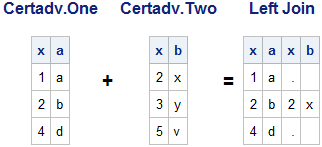
In each row of output,
the first two columns correspond to table One (the left table) and
the last two columns correspond to table Two (the right table).
Because this is a left
join, all rows, both matching and nonmatching, from table One are
included in the output. Rows from table Two are included in the output
only if they match a row from table One. In the output, the rows from
table One are the first two columns and the rows from table Two are
the last two columns.
The second row of output
is the only row in which the row from table One matched a row from
table Two, based on the join conditions specified in the ON clause.
In the first and third rows of output, the row from table One had
no matching row in table Two.
Note: In all three types of outer
joins (left, right, and full), the columns in the result (combined)
row that are from the unmatched row are set to missing values.
Example: Eliminating Duplicate Columns in a Left Outer Join
To eliminate one of
the duplicate columns in any outer join, you can modify the SELECT
clause to list the specific columns that will be displayed. The SELECT
clause from the preceding query has been modified to remove the duplicate
X column.
proc sql;
select one.x, a, b
from certadv.one left join
certadv.two
on one.x=two.x
;
quit;
Output 3.11 PROC SQL Query Result: Left Outer Join without Duplicate Rows
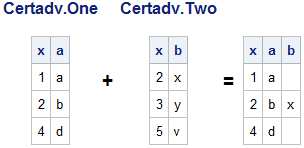
Example: Using a Right Outer Join
A right
outer join retrieves all rows that match across tables, based on the
join conditions, plus nonmatching rows from the second table that
are specified in the FROM clause. The following PROC SQL query uses
a right join to combine rows from tables One and Two, based on the
join conditions that were specified in the ON clause.
proc sql;
select *
from certadv.one right join
certadv.two
on one.x=two.x
;
quit;
Output 3.12 PROC SQL Query Result: Right Outer Join Output
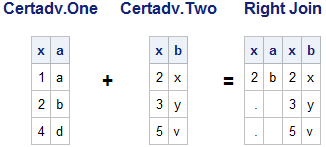
In each row of output,
the first two columns correspond to table One and the last two columns
correspond to table Two.
Because this is a right
join, all rows, both matching and nonmatching, from table Two are
included in the output. Rows from table One are displayed in the output
only if they match a row from table Two. There is only one row in
table One that matches a value of X in table Two, and these two matching
rows combine to form the first row of output. In the remaining rows
of output, there is no match and the columns corresponding to table
One are set to missing values.
Example: Using a Full Outer Join
A full
outer join retrieves both matching rows and nonmatching rows from
both tables.
proc sql;
select *
from certadv.one full join
certadv.two
on one.x=two.x
;
quit;
Output 3.13 PROC SQL Query Result: Full Outer Join Output
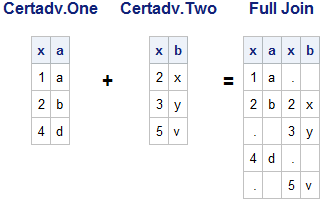
Because this is a full
join, all rows, both matching and nonmatching, from both tables are
included in the output. There is only one match between table One
and table Two, so only one row of output displays values in all columns.
All remaining rows of output contain only values from table One or
table Two, with the remaining columns set to missing values.
Example: Complex Outer Join
Suppose you want to
list all of an airline's flights that were scheduled for March,
along with any available corresponding delay information. Each flight
is identified by both a flight date and a flight number. Your output
should display the following data: flight date, flight number, destination,
and length of delay in minutes.
The data that you need
is stored in the two tables shown below. The applicable columns from
each table are identified.
|
Table
|
Relevant Columns
|
|---|---|
|
Certadv.Marchflights
|
Date, FlightNumber,
Destination
|
|
Certadv.Flightdelays
|
Date, FlightNumber,
Destination, Delay
|
Your output should include
the columns that are listed above and all of the following rows:
-
rows that have matching values of Date and FlightNumber across the two tables
-
rows from Certadv.Marchflights that have no matching row in Certadv.Flightdelays
To generate the output
that you want, the following PROC SQL query uses a left outer join,
with Certadv.Marchflights specified as the left table.
proc sql outobs=20; title 'All March Flights'; select m.date, /*1*/ m.flightnumber label='Flight Number', m.destination label='Left', f.destination label='Right', delay label='Delay in Minutes' from certadv.marchflights as m left join /*2*/ certadv.flightdelays as f on m.date=f.date /*3*/ and m.flightnumber=f.flightnumber order by delay; /*4*/ quit;
| 1 | The SELECT clause eliminates the duplicate Date and FlightNumber columns by specifying their source as Certadv.Marchflights. However, the SELECT clause list specifies the Destination columns from both tables and assigns a table alias to each to distinguish between them. |
| 2 | The FROM clause lists the tables to select from. The FROM clause uses the AS keyword to distinguish a table alias from other table names. The FROM clause also specifies the LEFT JOIN keyword to specify the join type. |
| 3 | The ON clause contains two join conditions, which match the tables on the two columns Date and FlightNumber. |
| 4 | The ORDER BY clause specifies the order in which rows are displayed in the result table. |
The first 12 rows in
the output display rows from Certadv.Marchflights. The rows that have
no matching values with Certadv.Flightdelays display missing values
for those columns. Therefore, the first 12 rows have missing values.
Output 3.14 PROC SQL Query Result: Outer Join
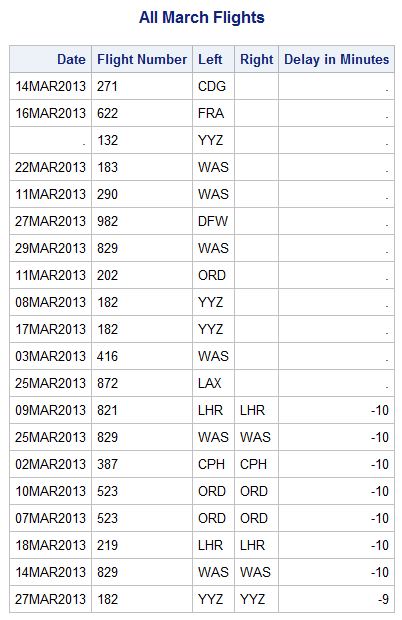
Note: The same results could be
generated by using a right outer join, with Certadv.Marchflights specified
as the right (second) table.
Last updated: October 16, 2019
..................Content has been hidden....................
You can't read the all page of ebook, please click here login for view all page.
